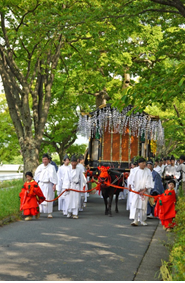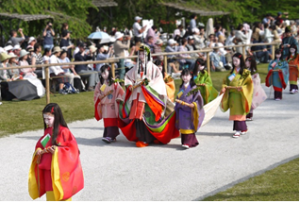FK5 Aoi Matsuri
 |
 |
Yoshie Doi
This year’s Aoi Matsuri has also been canceled for the third consecutive year. It has a long history, and 1400 years ago, during the time of Emperor Kinmei, the wind and rain in Japan was so severe that five grains did not grow. When the emperor demanded to Urabeno-Ikiwakahiko to do fortune telling, it was said that it was incur divine wrath of the god of Kamo. On the good day of April of the lunar calendar, he decorated the leaves of Aoi and Katsura based on the oracle, put a bell on the horse, put on a boar head, and ran the horse, and the wind and rain subsided. .. And it became a good harvest and the people became safe.
This prayer ritual remains today. It is located in Tadasu-no-Mori. Emperor Saga had his beloved Himemiko, Uchishinai-Shinno, serve at Kamo’s shrine, and since then, the Aoi Matsuri, which has devoted himself to serve as Saio, has become a festival throughout all the city.
In 819, it became a national event as the most important annual ritual in the imperial court’s decree system, and the tradition is called Aoi Matsuri until today. It is said that this is because the crowns and costumes of the people who participated in the festival and the cows and horses in the procession were decorated with Aoi leaves.
The official name of Aoi is a plant called Asarum caulescens, which has two leaves and magenta flowers at the base, and its morphology is said to symbolize both feet and genitals of the human body. It is said that the Aoi Matsuri is a Shinto ritual to pray for the maintenance of the race and the prosperity of the descendants.
After the founding of Heian, Kamigamo became the guardian deity of Yamashiro Province, and Emperor Saga sent his beloved princess, Himemiko/ Uchishi-naishin, to serve Kamo. Since then, the Aoi Matsuri, in which the Naishinno, who was dedicated to God, served as Saio, became a festival for the entire city.
The Kamo Festival came to be called the Aoi Matsuri only after the festival was abolished due to the Onin War and it was finally the Genroku era of peaceful world, and after that, the Aoi Matsuri became popular with the common people.
It was canceled due to the Onin War that lasted 11 years from 1467, and resumed in 1694. The Kamo Festival came to be called the Aoi Matsuri because the festival was abolished due to the Onin War, and it was finally protected by peaceful world. The Kamo Festival came to be commonly called the Aoi Matsuri after the procession event was revived in the 7th year of Genroku (1694) during the Edo period.
The end of document
